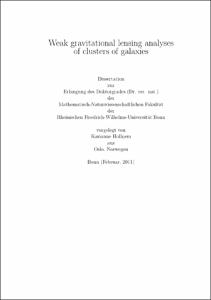Holhjem, Karianne: Weak gravitational lensing analyses of clusters of galaxies. - Bonn, 2011. - Dissertation, Rheinische Friedrich-Wilhelms-Universität Bonn.
Online-Ausgabe in bonndoc: https://nbn-resolving.org/urn:nbn:de:hbz:5n-24783
Online-Ausgabe in bonndoc: https://nbn-resolving.org/urn:nbn:de:hbz:5n-24783
@phdthesis{handle:20.500.11811/4963,
urn: https://nbn-resolving.org/urn:nbn:de:hbz:5n-24783,
author = {{Karianne Holhjem}},
title = {Weak gravitational lensing analyses of clusters of galaxies},
school = {Rheinische Friedrich-Wilhelms-Universität Bonn},
year = 2011,
month = apr,
note = {Comprising the most massive gravitationally bound and relaxed structures in the Universe, galaxy clusters are essential in providing a deeper understanding of the properties of dark matter. Being cosmologically young objects, they are undergoing strong evolution from redshift ~1 until today. The cosmological evolution of clusters thus provides a direct insight into the growth of cosmic structures. Gravitational lensing is an excellent tool for studying the mass distribution in the Universe, because it does not make assumptions about the nature or the dynamical state of the gravitating matter. In particular, lensing does not discriminate between the luminous and dark matter, and is thus a unique tool for studying the latter which otherwise evades observations. This aspect is very important for an analysis of the massive structures in the Universe, since dark matter dominates their state and evolution.
The topic of this PhD thesis is the analysis of galaxy clusters. Several different data sets are investigated, where cluster properties like mass, luminosity, and morphology are studied in detail, and correlations between them examined. Cluster characteristics obtained with different methods (e.g. gravitational lensing and X-ray) are compared to provide further insight into selection effects.},
url = {https://hdl.handle.net/20.500.11811/4963}
}
urn: https://nbn-resolving.org/urn:nbn:de:hbz:5n-24783,
author = {{Karianne Holhjem}},
title = {Weak gravitational lensing analyses of clusters of galaxies},
school = {Rheinische Friedrich-Wilhelms-Universität Bonn},
year = 2011,
month = apr,
note = {Comprising the most massive gravitationally bound and relaxed structures in the Universe, galaxy clusters are essential in providing a deeper understanding of the properties of dark matter. Being cosmologically young objects, they are undergoing strong evolution from redshift ~1 until today. The cosmological evolution of clusters thus provides a direct insight into the growth of cosmic structures. Gravitational lensing is an excellent tool for studying the mass distribution in the Universe, because it does not make assumptions about the nature or the dynamical state of the gravitating matter. In particular, lensing does not discriminate between the luminous and dark matter, and is thus a unique tool for studying the latter which otherwise evades observations. This aspect is very important for an analysis of the massive structures in the Universe, since dark matter dominates their state and evolution.
The topic of this PhD thesis is the analysis of galaxy clusters. Several different data sets are investigated, where cluster properties like mass, luminosity, and morphology are studied in detail, and correlations between them examined. Cluster characteristics obtained with different methods (e.g. gravitational lensing and X-ray) are compared to provide further insight into selection effects.},
url = {https://hdl.handle.net/20.500.11811/4963}
}






